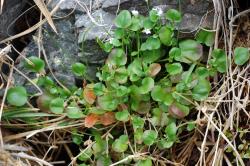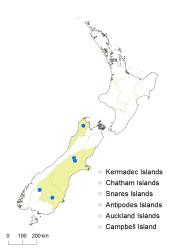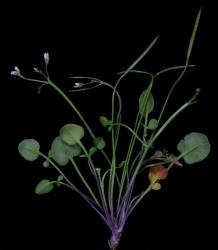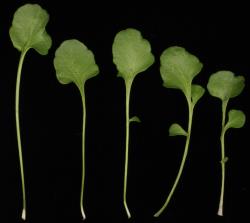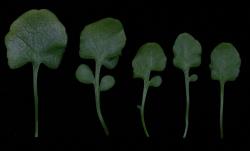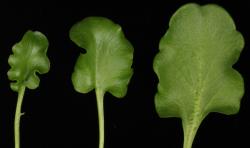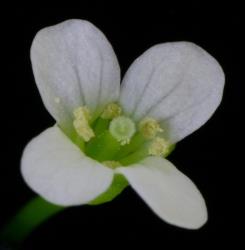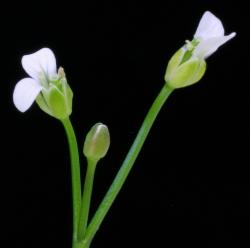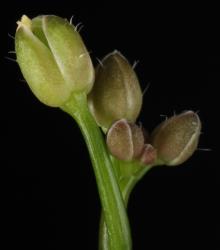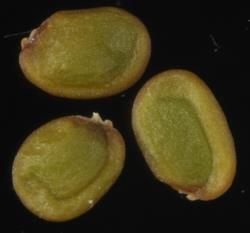Perennial herb, single rosette or with short lateral branches. Leaves up to 90 mm long, simple or pinnatisect, upright to spreading; lamina 4.0–30.0 × 2.5–15.0 mm, light green, membranous, usually glabrous on abaxial and adaxial surfaces, glabrous or sparsely hairy on margin and petiole; petiole up to 70 mm long, green and usually purple-red in lower half, glabrous to sparsely hairy, hairs 0.3–0.5 mm long, spreading to patent. Terminal pinna 5.0–18.0 × 5.0–15.0 mm, simple, oblong-orbicular, broadly elliptic-orbicular, elliptic-oblong to deltoid-oblong; margin usually shallowly sinuate to occasionally entire, hydathodes indistinct; apex obtuse, hydathode indistinct; base truncate, obtuse, to weakly cordate. Lateral pinnae 1–2(–4), 2.0–8.0 × 1.5–6.0, orbicular, broadly elliptic-orbicular, deltoid-orbicular to rhomboid-orbicular; margin entire, occasionally weakly lobed, hydathodes inconspicuous; apex obtuse; base truncate to cuneate, often oblique; petiolule 0.2–1.0 mm long, often appearing ± sessile. Cauline leaves similar to rosette leaves but smaller, terminal pinna often pinnatifid, pinnae bases attenuate to truncate; terminal pinna up to 10.0 × 6.0 mm, lateral pinnae up to 8.0 × 4.5 mm. Inflorescence with solitary flowers or 1–3 corymbs, corymbs 2–6-flowered; peduncle up to 100 mm long, 0.5–1.0 mm diam. at base, spreading to ascending, glabrous. Pedicels 15.0–115.0 mm long, 0.3–0.7 mm diam., terete, glabrous. Sepals 1.8–2.2 × 0.7–1.2 mm, elliptic-oblong, saccate, green or red-brown; glabrous to sparsely hairy; margin white and membranous, apex obtuse, base truncate. Petals 1–4, or absent; 4.5–5.5 × 2.1–3.0 mm, white, limb obovate; apex obtuse; base cuneate, tapering to a 1.0–1.5 mm long claw. Stamens 4–6; median filaments 2–4, 2.0–2.6 mm long; lateral filaments 2, 1.6–2.2 mm long; anthers 0.5–0.6 mm long, cream to pale yellow, when dehiscent held at a similar height to or slightly below the stigma. Ovary 2.6–2.9 mm long, 0.4–0.6 mm diam., ± terete, green, glabrous; ovules 20–20; style c. 0.2 mm long, ± terete; stigma 0.4–0.5 mm diam., white. Siliques 18.0–25.0 × 1.0–1.2 mm, glabrous, style 0.2–0.4 mm long; valves green at maturity and when dehiscent; replum 0.4–0.5 mm wide. Seeds 0.9–1.2 mm long, 0.5–0.7 mm wide, 0.3–0.4 mm thick, oblong to broadly oblong, henna; wing absent.
Cardamine sinuatifolia is distinguished by usually simple leaves, although occasionally they have 1–2 lateral pinnae, light green colour, margin with inconspicuous hydathodes, and purple-red petiole bases and stems. A notable feature of the terminal leaflets is their irregular shape, a tendency to be elliptic or oblong, and the weakly sinuate margin.
South Island: Western Nelson, Canterbury, Otago.
Cardamine sinuatifolia is currently known from a few collections in Western Nelson, Canterbury and Otago, but the wide geographical range of C. sinuatifolia in the South Island suggests it is likely to be more common.
Cardamine sinuatifolia prefers to grow in damp sites such as lake margins and stream banks.
Cardamine sinuatifolia is assessed as having a conservation status of At Risk—Naturally Uncommon, with the qualifiers Range Restricted, Data Poor and Sparse (de Lange et al. 2018). The qualifier Data Poor is applied because there is a lack of information on the number and size of the populations. Sparse is applied to reflect the current distribution, but further populations will almost certainly be located since its habitats are common throughout its distributional range.
Flowering January–December; Fruiting January–March.



